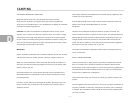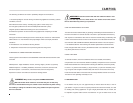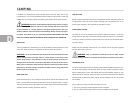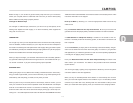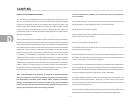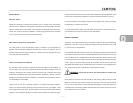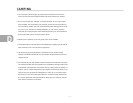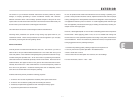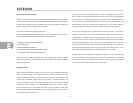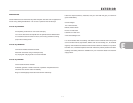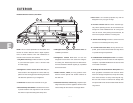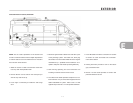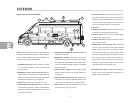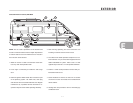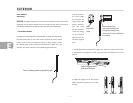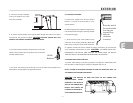
E
EXTERIOR
E - 2
How to Care for Your RV Finish
Keeping your RV looking its best at all times involves keeping the paint finish clean
and in good condition. This means periodic washing and polishing, as well as getting
the paint finish repaired as soon as possible when the paint is damage or affected in
anyway. The purpose of the paint finish is twofold:
(1) Provide an aesthetically pleasing appearance.
(2) To protect the vehicle from the environment. Your RV is exposed to many environ-
mental conditions that have an adverse effect on the paint finish:
1. ROAD SALTS AND SODIUM CHLORIDE
2. ROAD TAR/BUGS
3. BIRD DROPPINGS/TREE SAP
4. INDUSTRIAL FALLOUT/ACID RAIN/POLLUTION
5. ULTRAVIOLET EXPOSURE AND MOISTURE
The most common problems resulting from these conditions are corrosion, staining
and chemical spotting. These problems can be minimized through regularly scheduled
washing and polishing.
Washing your RV:
Make sure the RVs surface temperature is not too hot, under 90 degrees Fahrenheit,
and not in direct sunlight. A shady area is ideal for washing your vehicle as direct
sunlight causes water and soap to evaporate too fast, resulting in water spotting. Use
a mild soap or detergent. Most auto care stores carry a car wash shampoo. Try
to avoid combination wash-n-wax products as these waxes cause buildup and are
designed for smaller surfaces. Have two dedicated sponges or wax mitts: one for
the paint finish and one for the wheels and under carriage. Brushes or wash mitts
that have plastic bristles are acceptable for use on tires and wheel wells, but are not
intended for use on the paint finish.
Avoid using such items on painted surfaces, as they will damage the RV paint and
finish. Wash the wheels and wheel wells first as this removes heavy dirt and debris
and prevents it from splattering on already clean panels. Wet the entire area down to
remove loose dirt and grime, hand wash one area at time using your dedicated paint
finish sponge or wash mitt. Wash from the top and work your way down, frequently
rinsing the rinsing to minimize grit abrasion. Follow with a final rinse of water. If
This process will remove most contamination from the RVs surface. For stubborn
stains such as road tar, use an ammonia based glass cleaner or a small amount of
rubbing alcohol on a damp cloth immediately followed by warm soapy water and rinse
with clean water. This may not dissolve the road tar, but will loosen tar and bugs stains
and remove them from the surface. Do not use solvent based cleaners on bird drop
-
pings or tree sap as these are water-based stains and will eventually dissolve using an
ammonia based glass cleaner, warm soapy water and a little “elbow grease”. Once
again, after removing stubborn stains immediately rinse with clean water.
Drying the RV is just as important as washing your vehicle as today’s tap water and
well water contain many chemicals that could water stain your RVs finish. We suggest
using a damp natural or synthetic chamois, however, there are other drying products
such as lint free micro-fiber towels that work just as well.



